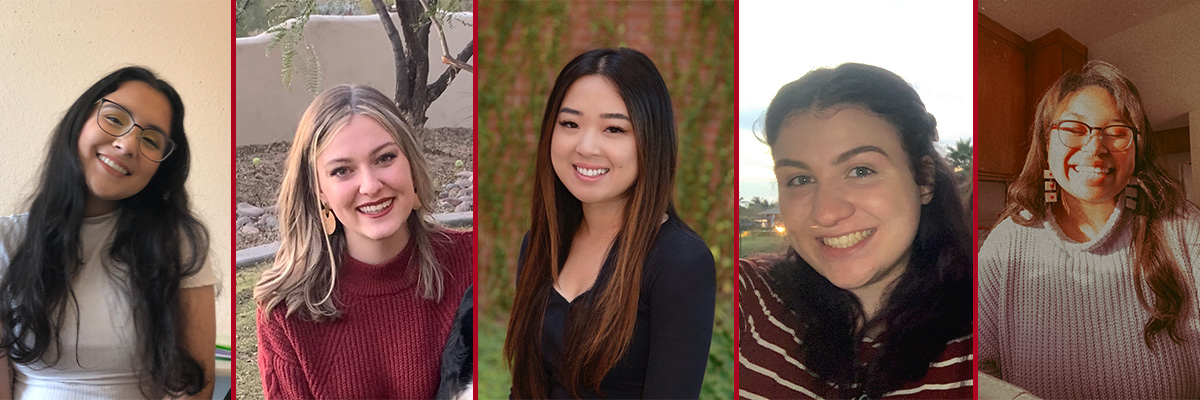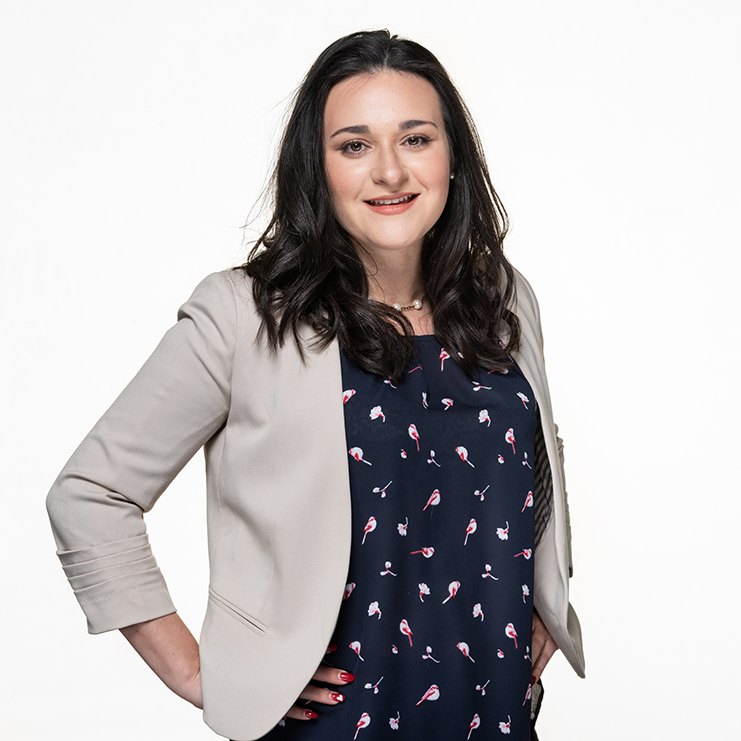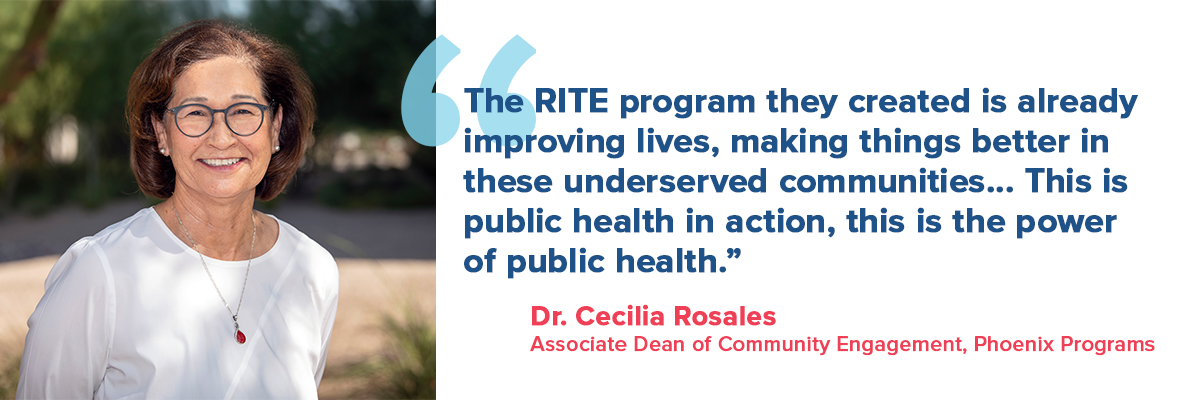Public Health Students Launch Tutoring Program to Support Remote Learning Challenges

When public health students learned that some elementary school students were struggling with online learning, they started a program to train high school students from the same communities to be tutors for the elementary students who needed help, and the Remote Integrated Tutoring Education (RITE) program was born.
In August of 2020, Sheila Soto, MPH, Project Coordinator for the Mobile Health Units (MHUs) program from the University of Arizona’s Zuckerman College of Public Health – Phoenix Campus (COPH-P), reached out to Dr. Cecilia Rosales, Associate Dean of Community Engagement, Phoenix Programs, about an emerging challenge. Soto and the MHU team were hearing from community members that elementary school kids were facing new education challenges. Due to the COVID-19 pandemic they were returning to school online, and many kids did not have the computer experience or resources that they needed to keep up. Those school children, predominantly from underserved communities in metro Phoenix, needed extra support, something like a mentor or a tutor.
 Dr. Rosales had seen the benefits of tutoring before, and she also knew that help from other members of the same community would be the most effective path to connect with the young students. She reached out to some public health students who were considering what to focus on for their required internship project, and the students liked the idea. This was the start of the project that would become the Remote Integrated Tutoring Education (RITE) program.
Dr. Rosales had seen the benefits of tutoring before, and she also knew that help from other members of the same community would be the most effective path to connect with the young students. She reached out to some public health students who were considering what to focus on for their required internship project, and the students liked the idea. This was the start of the project that would become the Remote Integrated Tutoring Education (RITE) program.
“From the MHU team, we knew there were students that needed help with the transition to online school, and we wanted to find tutors from the same communities,” said Dr. Rosales, “this was clearly something the community needed, and this would be a good project for our public health students.”
Two University of Arizona public health students – Lexi Tronzo, and Cierra Ashton Weaver – teamed up with a nursing major who had recently graduated from the College of Nursing - Elise Renae De La Torre. De La Torre had been a volunteer with the Mobile Health Units, and Sheila Soto connected her with Tronzo and Weaver. Together the students set to work to create a tutoring program for elementary school kids who needed help with the transition to online school. The idea was to find high school students from the same community as the elementary school students who would be willing to tutor the younger students.
“We did a lot of research about tutoring programs and I used my mapping skills from a public health course to map out school districts,” said Weaver, “we found high schools that were near elementary schools. Still, we ran into a lot of obstacles.”
“It was hard to find contacts at the schools because all the teachers and administrators were working remotely, and then we found Marco Ruiz, he’s the director of district activities for Fowler school district in southwest Phoenix, he became our key connection. He knew the high school principal and people at the elementary school,” said Tronzo, “and that’s how we got connected with Karen Furkert, she was a teacher at Sierra Linda High School and she had a group of students who wanted to become teachers. She recruited them to be tutors for the program.” Furkert is the leader of the Future Teachers course at Sierra Linda High School, which is the feeder school for Fowler Elementary School, so she recruited students who wanted to become teachers to work with the RITE tutoring program.
“The Sierra Linda Future Teacher's program is in its first year, and we're so grateful for the opportunity provided by the RITE program, so our students could apply what they are learning in class and help the elementary students,” said Furkert, “the program has been incredibly rewarding for our future teachers, and they gained experience in a career they want to pursue.”

Marni Rawiszer, program manager for outreach and development at CAAHEC
At the same time, Dr. Rosales reached out to her contacts at the Arizona Area Health Education Centers (AZAHEC), part of the University of Arizona Health Sciences, because this seemed like a project that aligned with their mission. Arizona AHEC serves the State of Arizona contractually through five regional centers to promote health education. One of the regional centers, the Central Arizona Area Health Education Center (CAAHEC) joined to support the project. “When Cecilia approached us and explained the project, we were excited,” said Marni Rawiszer, program manager for outreach and development at CAAHEC, “We love student-driven programs so we provided some funding and guidance, but we wanted the students to lead it. They really made it happen!”
Based on their research, the public health students developed training materials for the high school students to prepare them for their new role as tutors. At one point, they reached out to the THINK TANK Academic support services at the University of Arizona. Marco Ortiz, Director of THINK TANK, provided crucial guidance for the tutor training program. The public health student team really appreciated his expertise. “Marco was so helpful. We learned so much from him. And we knew this was a pilot, and we would be working out the kinks with the tutors,” said Cierra Ashton Weaver, “so we gave them our emails, we encouraged communication, it was a constant back-and-forth.”
Still, working with the schools was not easy. There were many forms to fill out, and many bureaucratic approvals to navigate. “We did not have a solid commitment from either the high school or the elementary school until late October,” said Elise Renae de la Torre. “We finally trained the tutors and they started tutoring just before Thanksgiving last year, then came the Thanksgiving break, then we started again after that until the holiday break.” All together, the RITE program provided six weeks of tutoring for the Fall 2020 semester.
“CAAHAC (Central Arizona Area Health Education Center) was a big help. Dr. Rosales brought them in. They supported us and cut through a lot of the red tape,” said Tronzo, “they were involved with the process all along. We could not have done it without them.” CAAHAC also provided some funding for the program.
“We talked a lot about the intention behind the program. When we talked to the tutors we emphasized that they are not just a tutor, they’re also a resource, a mentor, someone from their own community that the kids can look up to and talk to if they have struggles,” said Tronzo. “Especially in the Spanish-speaking community. And once the program was working, it was great to see the connections being made, and see communities empower themselves. We really tried to support the communities to help themselves.”
“Cultural competency was key. We really tried to be mindful that we were engaging the student tutors to empower themselves. The community health workers and the local leaders and teachers are all so important, and still ultimately you need people who are already in the community to help the community,” said Weaver. “The way we approached, it, we would succeed if our job goes away and the community continues the program. We don’t run it, they do, it’s sustainable.”
By the end of the Fall 2020 semester, the public health student team – Elise Renae de la Torre, Lexi Tronzo, and Cierra Ashton Weaver – had seen the relationships grow between the high school student tutors and the elementary school kids they were helping. They realized that they had created something truly valuable that was bringing benefit to the community, something that could last. The three students left the RITE program at the end of the Fall 2020 semester because they had completed their internship.
In Spring of 2021, the RITE program was up-and-running in Phoenix with support from Central Arizona Area Health Education Center (CAAHEC). Dr. Rosales asked Emily Waldron, Community Engagement and Outreach Coordinator for the Academic Health Department (AHD) at COPH to help guide the program forward. At the same time, two new public health students, Emma Sawyer, a senior public health major, and Sabrina Nguyen, an MPH student, joined the project to support and expand the RITE program. Sawyer and Nguyen work with the original schools in Phoenix, and they are also working to expand the program to Tucson in collaboration with Pueblo High School and the Future Health Leaders Alliance (FHLA) at UArizona. They also have support from Linda Cifuentes, capacity building coordinator at the Southeastern Arizona Area Health Education Center (SEAHEC), who is helping to expand the RITE project to Tucson.
“Now when we’re training the tutors, we try to highlight health disparities. We want to provide a public health lens in our training so the high school students start to understand the public health challenges in their communities,” said Emma Sawyer. “We encourage them to look at the social determinants of health and become culturally competent educators who think about the disparities in language and technology”
To track the results, Sabrina Nguyen is working on assessment for the RITE program in order to collect data and document the program’s success. She works with Emily Waldron from the Academic Health Department and Marni Rawiszer from CAAHAC on finding ways to evaluate the RITE program.
Looking ahead, Waldron hopes to work with Sawyer and Nguyen to establish the RITE program as an internship option for public health students, and possibly to create a 1-credit college course for the high school students who train and serve as tutors.

All together, the RITE program shows the power of public health. The existing community networks of the MHUs identified the need, then the students gathered resources and intelligence, built networks of relationships, and engaged schools to meet the need in the community. It is also an impressive example of how students, with determination and guidance, can work collaboratively to create a program that not only helps a community but also engages community members to help each other. Creating the program has been a very valuable educational process for the public health students. At many points they felt discouraged about their slow progress, and yet they persevered to create something that has the potential to add lasting value to the health and wellness of the community.
“I am so proud of our students. They did not give up. When things did not work out as planned, they found a way to move forward. And the RITE program they created is already improving lives, making things better in these underserved communities,” said Dr. Rosales, “this is public health in action, this is the power of public health.”

